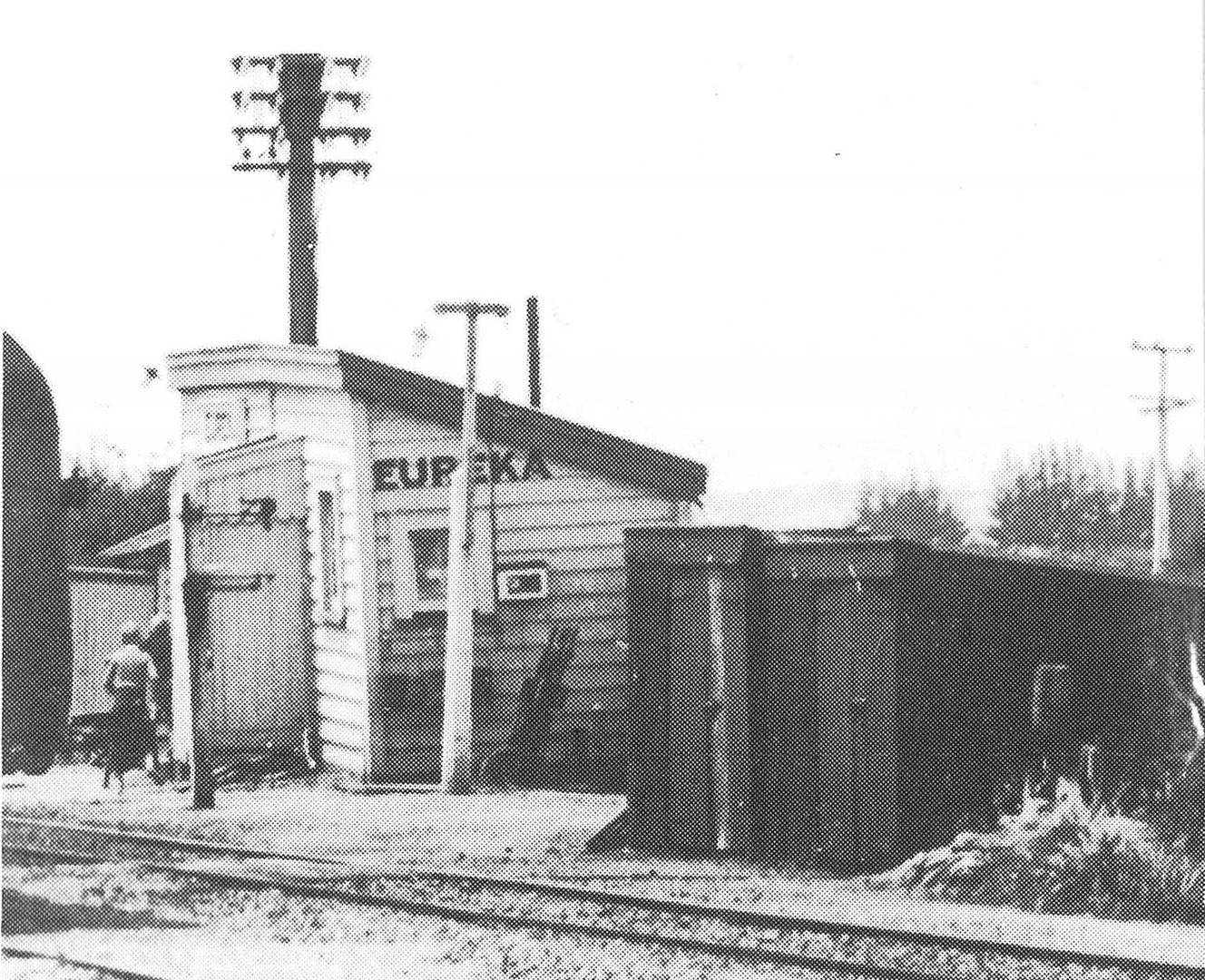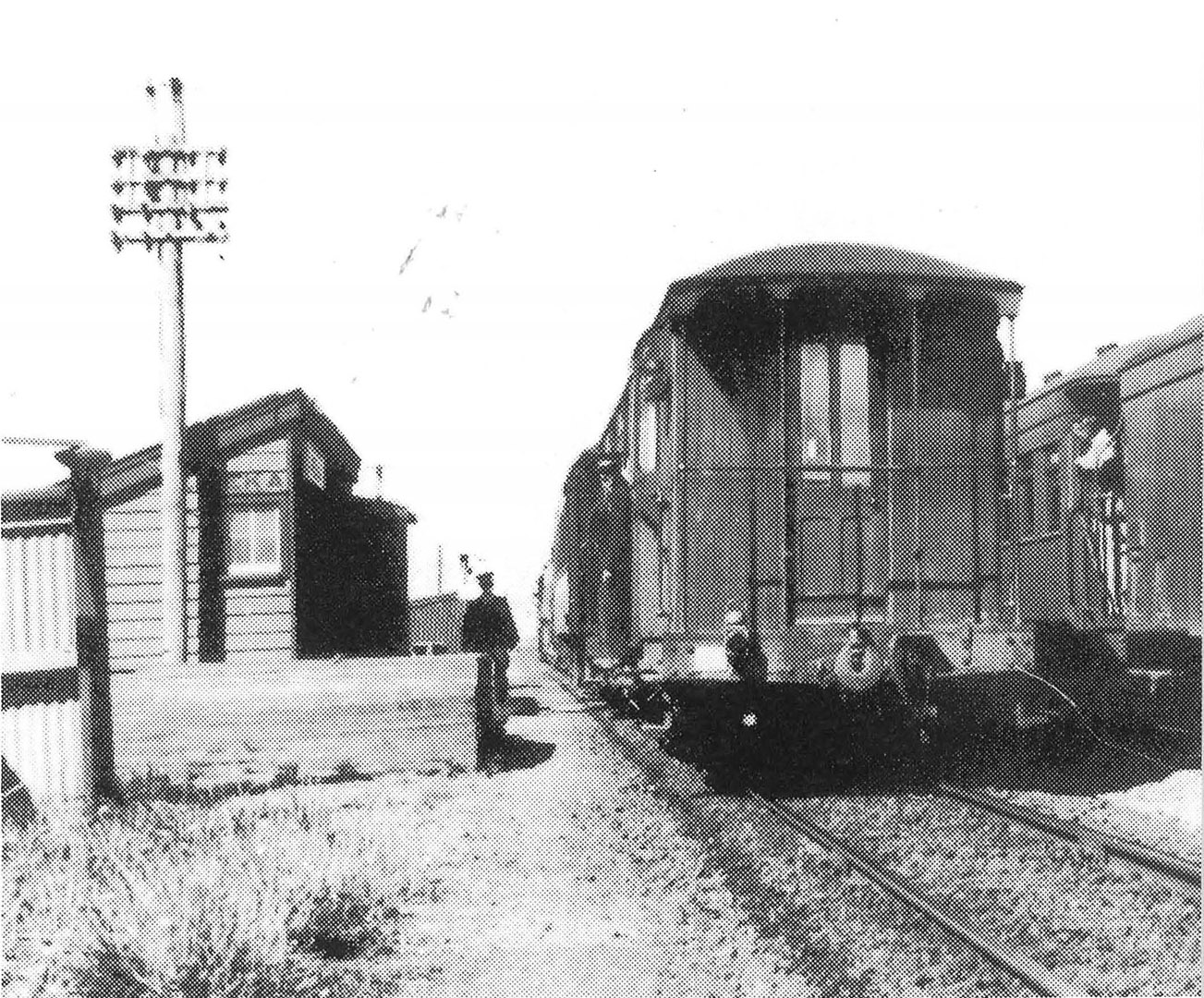
ALL the needs of the district, whether personal or for the farm, came by train and it was a friend indeed, a haven for many a bird-nest or a childish love affair...'1
Situated in the middle of the peat swamp Eureka Station was regarded as something of a wilderness junction by most travellers through the Waikato in the early 1900s. But to the prospering settlement it was an immense boon.
For until the advent of the railway, coaches were the main form of public transport in the district. Travelling by coach between the Waikato and Thames was an endurance test for many of the early settlers. Those who had journeyed between Te Aroha and Hamilton had vivid recollections of the miseries of the trip, the deplorable state of the roads, the potholes and slush.2 Consequently settlers in the Waikato and Thames districts eagerly awaited the day coaching would become a thing of the past. Their first glimmer of hope came in 1879. On a drizzly afternoon on May 1 that year New Zealand's Premier, Sir George Grey, turned the first sod at the Waikato end of the railway. The ceremony took place in a grass paddock at the rear of F. R. Claude's farm in Hamilton East.'3 On October I, 1884 their dreams were realised as the first passenger and goods train pulled into Morrinsville.
* * *
Coaching in the Piako area in the 1870's was an arduous business. Those who travelled in the vicinity in the winter or rainy season had to endure bleak scenery and wretched roads over which they had ridden or been dragged.
Coaches were often stuck in boggy patches. Serious accidents along the trail were not uncommon when horses became bogged down and threw their riders. 4
For bad weather trips spades and shovels were a 'must' on coaches.
In the Piako Swamp area coaches often made a stop at the Tauwhare township. A large two-storeyed hotel was opened there in 1883 to serve the coach route. The proprietor offered beds and meals to the weary passengers. 5
Work on the railway line from Hamilton began at the end of 1879, two years after Sir George Grey had turned the first sod at the Thames end of the line.
The successful tenderers for the formation of the first section from Hamilton were Hunt and White of Auckland. By October 1880 they had completed the 21 kilometres stretch-at a cost of 9930 pounds. The contract for the "permanent way" of the Eureka contract was given to Mullinger and Brett. The 27 kilometres cost 11,943 pounds to complete. Work on the Morrinsville contract began in June 1881 and was completed by the autumn of 1882. It cost 3494 pounds and the work was carried out by W. Lovett of Hamilton.6
Communities for miles around anxiously watched the progress. A Te Aroha correspondent for the Waikato Times wrote in May 1884: "Much satisfaction is felt here with the progress made on the Eureka section of the railway that is to connect us with the Waikato. The rails are now linked nearly to Morrinsville and it is hoped that in two or at most three months the line to that place will be in full operation''. In the meantime tenders for the construction of the stations were called.
The contract which would have included Eureka was given to W. Cameron and Price and Malcolm. Engineering problems in the construction of the Hamilton bridge held up the opening of the line. Finally, on January 8, 1884 the first trolley went across the bridge and the first engine crossed it -at five miles an hour.' 7 In October that year a new era in the history of the Piako district was inaugurated with the opening of the line. 8
"All who are interested in the prosperity of the Waikato may now look with satisfaction to the vast tract of valuable country which this extension of the railway has now opened up to settlement," wrote a Waikato Times correspondent. 9
"Though the country between this district and Morrinsville has been in the hands of Europeans for many years past, settlement on anything like an extensive or progressive scale has been greatly retarded by the miserable means of communication which an indifferently formed surface road has afforded. ' '
And though the opening of the railway was greeted with cheers in Morrinsville, the location of Eureka Station was a sore point for some of Eureka's residents. Most of the farms situated near the Cambridge-Morrinsville road were some distance from the station. The settlers there felt the station, flanked by ti-tree, flax and rushes was built out in the wilderness.
The Waikato Times comments on Eureka Station were in the same vein:
The country passed through on a trip to Morrinsville is certainly anything but of an encouraging and picturesque character. On the contrary it is exceedingly disappointing and is not likely to favourably impress the mind of a visitor. After passing through Claude's bush the train emerges on the vast swamp property of the (New Zealand) Land Association.
And now a dreary ride through a veritable waste commences, altogether unequalled in railway travelling in the province. The swamp is about 11 miles across and in places seems to extend on either side almost to the horizon.
. . . To all appearances the Eureka Station is isolated from the outside world. It is well in the middle of the swamp and the road giving access to it if it is intended that the station shall be of any practical utility to the district might profitably be reformed and otherwise improved. The Eureka homestead with its well planted surroundings is the only attractive feature in the vicinity.10
Eureka Station had at least three rooms as it was graded a fourth class station. There were railway houses for the station agent and gangers who worked on maintaining the line. These were probably erected whilethe'tracks were being laid. The station buildings sat out on the swamp on the south side of the line. The goods shed, cattleyards and station-master's house were on the opposite side.11
At some point the goods shed must have been removed as in November 1907 a deputation from Eureka called on the Premier. They urged him to install a goods shed and improve postal facilities in the district.12
The farmers complained that they had suffered heavy losses as their manure and other goods had been damaged by water seepage. They called for adequate shelter to handle the goods in wet weather and some kind of system to alert settlers when their goods arrived at Eureka.
By 1908 a new shed had been erected. Fixed signals and a tablet system came into use. The tablet method was a token system which allowed the driver to proceed to the next station once he had received the tablet at Eureka.
As the track was built on peat over the Eureka stretch, the community's old-timers recall watching the track move up and down on the springy peat as the express trains thundered past. But when the station first opened only one train passed through. It left Morrinsville at 9.35 am and arrived in Frankton an hour later, returning from Hamilton at 2.40 pm.
Waggons waiting on the Eureka siding.



By 1915 the passenger and goods trains through Eureka were frequent. The station became the community's lifeline. Stock used to be loaded on at 8.00 am and reached the Frankton yards by 9.30 am.13 Farmers living near the station sent their cream via rail to Frankton or Morrinsville. When the butter factory and later the cheese factory were built at Eureka many of the factory's supplies came by rail.
Timetables were flexible then. The engine drivers knew most of the farmers who used the trains regularly. They stopped and waited if they sighted a cream cart clattering down Station Road (Eureka Road). On odd occasions the stationmaster let the children wave the red or green flags to passing trains and the drivers in turn whistled a "hello".
The older children used the trains to ride into Hamilton to high school. Their milking duties done, they had just enough time to get spruced up before they charged across the paddocks or galloped down to the station just in time to hop on.
The horizons for entertainment expanded. The Te Aroha races provided a welcome respite for the farmers while their wives took time out to go shopping in Hamilton. Gone were the days of travelling into Hamilton by horse and gig.
The annual Ngaruawahia regatta for many years was a special family outing. The train ride there and the regatta were a special treat for the children.
The station was eventually closed down when the passenger trains were taken off. The familiar sight of gangers pulling themselves along the tracks on hand-worked jiggers disappeared. Only goods trains still passed through to the East Coast. The Rotorua railcar ceased running on November 12, 1968 and the railcar to Te Puke was stopped in 1967.14
The station staff and their families were part of the Eureka community.
Two of the longest serving station families were the Tom Dawsons and Mr and Mrs Harry Cronin. The Cronin family came to Eureka in 1945 and their children, John, Margaret, Lois and Pamela all attended school in Eureka. The whole family played a very active role in the community being involved in everything from Social Club to tennis and bowls. Harry is remembered for his part in skits at concerts. It was all great fun and they were missed on their departure in 1959.
Some of the staff who have served at Eureka Station are: J. Clemmelt, W. Walker, Hodgson, J. Holt, T. Dawson, J. Peebles, T. Cork, E. Murray, C. Hale, E. Hunter N. Kaire, J . Hale, D. Love, Tairi, B. Kingi, C. Gaylard, Bromley Whitely, J. Nesdale, H. Cronin, Brierley, L. Taylor, J. Heke, Bryant, Terry, McCarthy, W. Johnston, R. Mcllwraith and F. Petrocivitch.
The tracks, once level with the road, now lie high above it. The peat on either side has subsided more than two metres over the years. The station buildings and houses have long since gone, some of them sold and others pulled down. (The goods shed is for example still in use on Van Vugts' farm) . The place, so often a hive of activity for the early settlers lay disused for many a year.
But on October 16, 1983 sixty-four Eureka residents once more flagged down a train. The special excursion train was put on by the Morrinsville and Hamilton East Lions Clubs and made a special stop at Eureka. It took them on a day trip to Mount Maunganui and returned to Hamilton with a stop at the junction in the wilderness to let off its Eureka passengers.

